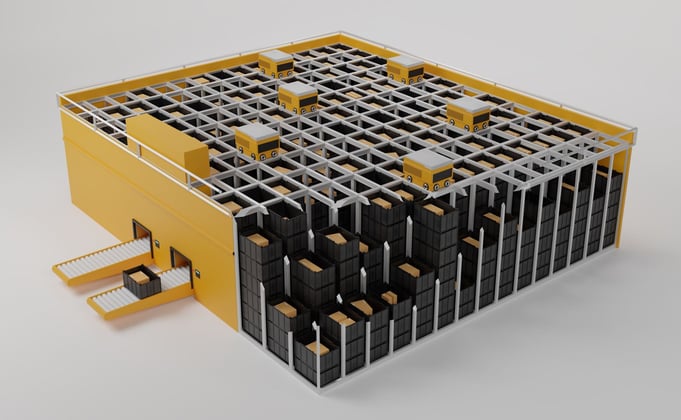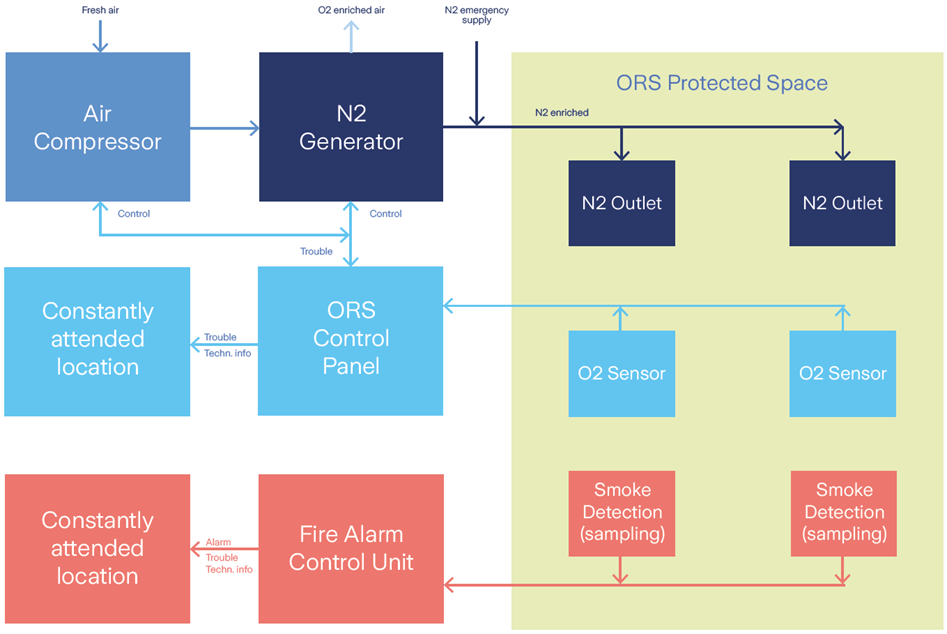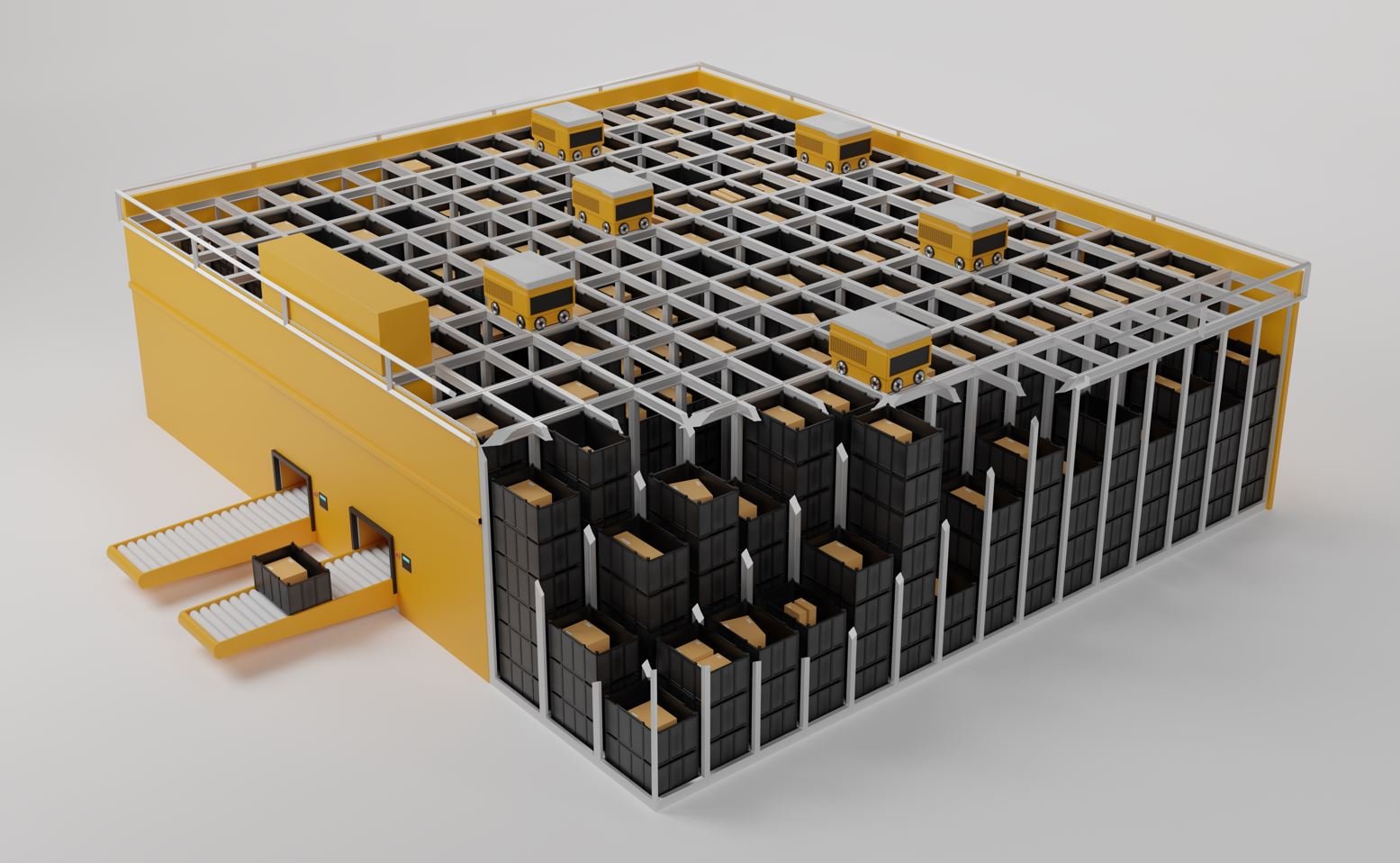Oxygen Reduction Systems could prevent complete loss of your automated storage and retrieval system
ArticleFebruary 22, 2023
Traditional fire protection systems such as automatic sprinklers control or suppress fires until the fire brigade can finally get to, and extinguish the fire. However, new storage and retrieval systems are more dense and limit fire brigade access to the storage array, making final extinguishment very difficult. Read more to take part of Zurich Nordic’s risk engineer and oxygen reduction systems (ORS) researcher Martin Nilsson’s solution to the problem.
There are examples where top loading automated storage and retrieval systems (ASRS) have been completely lost, even though sprinklers controlled the fire for a significant period of time. The reason being that the fire brigade could not reach the seat of the fire and eventually the sprinkler water supply got depleted. Lowering the oxygen concentration as a means for fire protection can be a solution where the need for final extinguishment by the fire brigade is extremely limited preventing complete loss of the ASRS and building.
Traditional final extinguishment and dense storage
Recent developments in the logistic industry call for more efficient storage solutions and top-loading ASRSs have increased during the last years.
Final extinguishment of storage fires is a two-step process.
1. Sprinklers of adequate design control or suppress the fire
2. Firefighters achieve final extinguishment, and fire-damaged goods are removed

Example of top-loading ASRS storage array
Nevertheless, fire experience indicates some storage configurations may be too challenging to achieve Step 2. In these cases, an adequately sprinklered building may still be lost to fire. One particular instance where this risk is present is top-loading automatic storage and retrieval systems where the storage is kept in plastic totes stacked on top of each other creating a very dense storage where firefighting access is very difficult.
Oxygen Reduction Systems (ORS) - A possible solution to the final extinguishment challenge
ORS are intended to minimize the impact of fire inception hazards and avoid fire propagation beyond the point of ignition by maintaining a continuously reduced oxygen level within a protected space. This is maintained by adding nitrogen into the protected space.
Traditional fixed fire protection systems release an agent instead, such as water, in response to a developing fire once the fire is detected. For example, when enough heat causes an automatic sprinkler head to operate.
ORS, on the other hand, may be viewed as a fixed fire protection system with a “head start”. Rather than waiting for fire growth and fire detection, the fire protection is continuously maintained in the protected space through the reduced oxygen atmosphere. Oxygen reduction can be used for applications where traditional fixed fire protection systems are not considered to offer a credible solution to protect the occupancy, such as top-loading ASRSs where the plan for final extinguishment is not credible.

Schematic of an oxygen reduction system
Design guidance for ORS
Discuss any planned ORS installation with your Zurich Resilience Solution representative and submit plans, drawings, calculations etc. for review prior to commencement of any work. For design and installation follow the guidance in the Zurich Risk Topic Fixed fire protection – Oxygen reduction systems, where chosen parts are summarized below. In general VdS 3527 - VdS-Guidelines for Oxygen Reduction Systems, Planning and Installation should be followed, except for the design oxygen concentrations which needs to be lower than the concentrations recommended in the VdS standard.
The key parameter ensuring successful protection by ORS is the chosen design oxygen concentration. A too high oxygen level will not limit the fire. The design oxygen concentrations, ignition thresholds and test methods for determining the ignition thresholds provided in e.g. EN 16750, ISO 20338 and VdS 3527 are not acceptable for property protection purposes since a fire may still develop with those concentrations. Instead, apply 11.1% design oxygen concentration for any ordinary combustibles. (13.0% is an acceptable design oxygen concentration where all combustible materials in the protected space are plastics.)
Maintaining the required oxygen level is highly dependent upon the tightness of the building. Hence efforts are needed to keep the building envelope tight and to control transport in and out of the space.
Conclusions and Zurich efforts
Oxygen reduction systems (ORS) offer an option to traditional fixed fire protection systems. The ORS is intended to minimize the impact of fire inception hazards and help avoid fire propagation beyond the point of ignition by maintaining a continuously reduced oxygen level within a protected space.
Where the protected space can be maintained tight enough to allow the ORS to operate efficiently and where a sufficiently low reduced oxygen level can be maintained, ORS is an acceptable property protection option in situations where traditional fixed fire protection systems are not considered to offer a credible solution to protect the occupancy.
Zurich is actively conducting research on ORS together with Lund University in a research project funded by the Property Insurance Research Group which is part of the NFPA Fire Protection Research Foundation.
For more information contact our ORS researcher Martin Nilsson, Senior Risk Engineer at Zurich Nordic.
